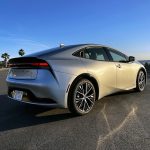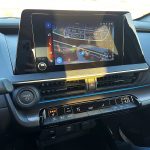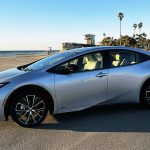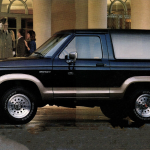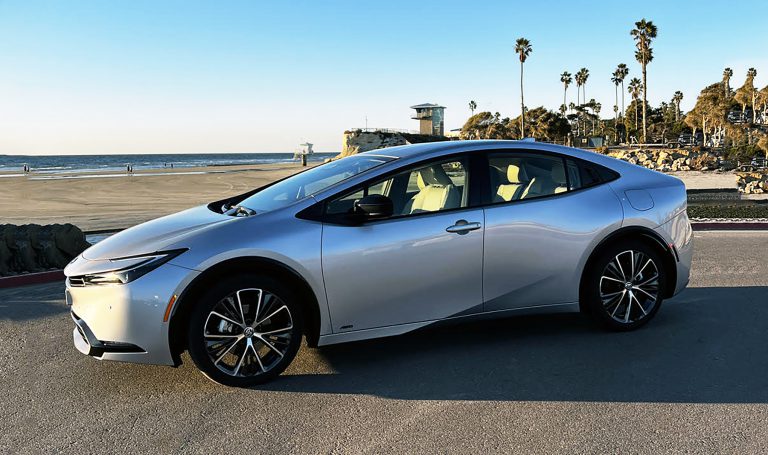
 It was weird. When I rounded the corner, a guy walking down the street stopped suddenly, whipped out his phone, and started acting like a paparazzo, taking pictures of my test car like it was a super star. Add this incident to the to the number of thumbs-up signs my test car scored, and you’d suspect I was driving something rare and exotic. But I wasn’t. I was driving a 2023 Toyota Prius…something decidedly un-exotic.
It was weird. When I rounded the corner, a guy walking down the street stopped suddenly, whipped out his phone, and started acting like a paparazzo, taking pictures of my test car like it was a super star. Add this incident to the to the number of thumbs-up signs my test car scored, and you’d suspect I was driving something rare and exotic. But I wasn’t. I was driving a 2023 Toyota Prius…something decidedly un-exotic.
Yes, it’s all-new for the 2023 model year. And, yes, it has a radically new svelte shape. But it was still a Prius. Just goes to show eco-chic can be ultra-cool. But there’s more than a new look going on here.

Beyond the obviously reimagined new design, the most significant changes to Toyota’s stalwart fuel-saver come under the hood. Replacing a 1.8-liter 4-cylinder engine is a new 2.0-liter unit mated to a pair of electric motors. The new set up delivers a combined output of up to 196 horsepower on all-wheel-drive models, and 194 horsepower on front-wheel-drive models. That’s a whopping 60-percent power increase over the outgoing model, which delivered a combined 121 horsepower.
Test Drive: 2022 Ford Escape Titanium PHEV
Toyota had both the new and old Prii (Prii, by the way, is the actual, official, brand-approved plural of Prius) on hand for back-to-back tests, and as you would imagine the power upgrade is apparent. Where the 2022 model might have felt sluggish and uninspired, the 2023 Prius was smooth and light on its feet. The hybrid engine/motor interplay, which can be balky, was generally seamless. From a city girl’s perspective, this new Toyota hybrid will be potent enough for highway merges and passing maneuvers, but still refined enough for smooth urban drives.
The beauty of Prius hybrid system is that you enjoy both power and efficiency, in part because both motor-generators are employed to charge the lithium-ion battery during braking and periods of light engine demand. The Electronically Controlled Brake (ECB) system, as Toyota calls it, helps to make the 2023 Prius the most-efficient iteration of the model to date.
About that efficiency: Toyota is touting the car’s 57-mpg EPA combined estimate, which is impressive, but that’s for the base front-drive LE model on standard 17-inch wheels. Opt for a mid-level XLE, or top-trim Limited equipped with AWD, and your mileage drops to just 49 mpg—which is still pretty impressive. A few more numbers: a base LE with AWD is, according to the EPA, is good for 54 mpg, and front-drive versions of the XLE and Limited 52 mpg.
Best Mileage: 2022 Consumer Guide Fuel-Economy Champions (No Plug-ins)
My test-drive opportunities did not allow for any real fuel-economy evaluations, but every vehicle I sampled reported mileage in the 45-48 mpg range. Especially impressive given the demands of a media test drive.
While the car’s new design, smooth power, and fuel economy impress, not everyone is taken with the gauge cluster. Similar to the setup in Toyota’s new all-electric bZ4X compact crossover, the cluster in the Prius appears on a narrow triangular panel that juts up over the dash in front of the driver. The net effect is less like viewing a conventional instrument cluster, and more like watching a head-up display.
This worked well enough for me, but taller drivers complained that the steering wheel top bisected the cluster, obscuring the instruments. This is definitely one of those “try it before you buy it” situations, and a reminder of the value of a thorough test drive.
The rest of the interior is simply designed with minimalist horizontal lines. You have buttons for your climate controls, and a volume knob (hurray!), but radio tuning comes by way of the touchscreen.
The new Prius infotainment system is similar to the one we’ve seen in the Toyota Tundra, GR Corolla, and bZ4X, and it includes wireless Apple CarPlay/Android Auto integration, as well as a solid base of voice prompts for navigation and other hands-free controls.
Test Drive Gallery: 2022 Toyota RAV4 Hybrid Limited
While I like pretty much everything about the interior, there is one big miss, and that’s the available wireless charger. Toyota did a nice job with the design and location, but the problem is that it overheats your phone (to the point of sluggishness, but not shut-down failure) in less than 30 minutes.
Before you shrug your shoulders and say, that’s just what wireless chargers do, I’ll point out that I’ve driven several General Motors test vehicles that put a cool pad under the wireless charger, and that in these vehicles my phone not only charges faster, but also stays cooler.
For 2023, Prius drops the base L Eco trim and dives right into the LE. Pricing, including destination, and key features for each trim are as follows:
LE ($28,545): 17-inch allow wheels, 8-inch infotainment screen, 6-way adjustable fabric front seats in black or gray, blind-spot monitoring with rear cross-traffic alert.
XLE ($31,990): 19-inch alloy wheels, auto-dimming rearview mirror, driver and front-passenger heated seats, heated steering wheel, 8-way power driver’s seat, leatherette seating surfaces, rain-sensing wipers, passive entry, wireless phone charger, front-and-rear parking assist with automatic braking. Options include: 12.3-inch infotainment screen, fixed glass roof, digital key.
Limited ($35,560): 12.3-inch infotainment screen, JBL premium audio with 8 speakers, fixed glass roof, driver and front-passenger ventilated seats, 8-way power driver’s seat with memory, digital key, power back door. Options include 360-degree monitor, digital rearview mirror, heated rear seats, advanced park assist.
All-wheel drive is a $1,400 add on top of these prices.
Base model to base model, the 2023 Prius is $2375 more expensive that the ’22. But, LE to LE, the new car is up just $1165. For a completely new model with more power, lots of new technology, and sexy (yep, I’m saying it) good looks, the 2023 Prius is well worth the asking price.
Though Toyota revealed the next-gen 2023 Prius at the LA Auto Show, it won’t be available in dealers until June.
Test Drive: 2022 Ford Maverick Lariat (Hybrid)
Listen to the Consumer Guide Car Stuff Podcast
2023 Toyota Prius Gallery
(Click below for enlarged images
Car Stuff Podcast

